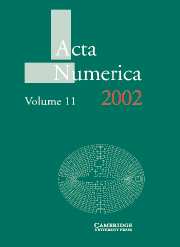Book contents
- Frontmatter
- Contents
- 1 Structured inverse eigenvalue problems
- 2 Subdivision schemes in geometric modelling
- 3 Adjoint methods for PDEs: a posteriori error analysis and postprocessing by duality
- 4 Finite elements in computational electromagnetism
- 5 Splitting methods
- 6 Topological techniques for efficient rigorous computation in dynamics
- 7 The immersed boundary method
- 8 Numerical methods for large eigenvalue problems
3 - Adjoint methods for PDEs: a posteriori error analysis and postprocessing by duality
Published online by Cambridge University Press: 21 May 2010
- Frontmatter
- Contents
- 1 Structured inverse eigenvalue problems
- 2 Subdivision schemes in geometric modelling
- 3 Adjoint methods for PDEs: a posteriori error analysis and postprocessing by duality
- 4 Finite elements in computational electromagnetism
- 5 Splitting methods
- 6 Topological techniques for efficient rigorous computation in dynamics
- 7 The immersed boundary method
- 8 Numerical methods for large eigenvalue problems
Summary
We give an overview of recent developments concerning the use of adjoint methods in two areas: the a posteriori error analysis of finite element methods for the numerical solution of partial differential equations where the quantity of interest is a functional of the solution, and superconvergent extraction of integral functionals by postprocessing.
Introduction
Output functionals
In many scientific and engineering applications that lead to the numerical approximation of solutions to partial differential equations, the objective is merely a rough, qualitative assessment of the details of the analytical solution over the computational domain, the quantitative concern being directed towards a few output functionals, derived quantities of particular engineering or scientific relevance.
For example, in aeronautical engineering, a CFD calculation of the flow around a transport aircraft at cruise conditions might be performed to investigate whether there are any unexpected shocks on the pylon connecting the engine to the wing, or whether there is an unexpected boundary layer separation caused by the main shock on the wing's suction surface. However, the engineer's overall concern is the impact of such phenomena on the lift and drag on the aircraft, and the quality of the CFD calculation is judged, first and foremost, by the accuracy of the lift and drag predictions. The fine details of the flow field are much less important, and are used only in a qualitative manner to suggest ways in which the design may be modified to improve the lift or drag.
- Type
- Chapter
- Information
- Acta Numerica 2002 , pp. 145 - 236Publisher: Cambridge University PressPrint publication year: 2002
- 30
- Cited by



